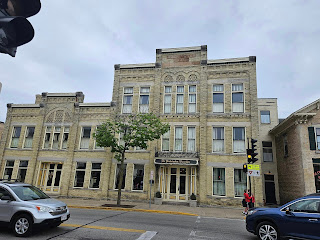More from our recent trip to Milwaukee Wisconsin. Why Wisconsin? Because we haven't been. And we found lots of things to enjoy, enough to think about making a return visit one day.
In part 1, I wrote about our visit to the Milwaukee Art Museum. Another historic site we visited was the Pabst Mansion ( https://www.pabstmansion.com/ ). Yes, that Pabst. Captain (title of a steamboat pilot and captain, no military service) Frederick Pabst happened to marry the daughter of the founder of the Best Brewing Company. When his father-in-law retired and handed him the business, Pabst changed the name and built Pabst into a major brewery. He became quite wealthy, in a city of wealthy German brewers, and built his family a new mansion on what was then called Grand Avenue, now Wisconsin Avenue. It was just one of some 60 mansions on the street, many larger in size even though the Pabst boasts 20,000 square feet and 30-something rooms. Today, it is the only one still standing. The rest were demolished over the years and replaced with apartment buildings and boarding houses. Completed in 1892, it was the Pabst home until 1908 when the family sold it to the Catholic Archdiocese. The Catholic Church updated it, while still preserving much of the original family artwork, furnishings, and decor, and made it the Archbishop's residence and Church headquarters until 1975. When the Church sold it in 1975, a group of citizens bought it for the purposes of preservation and transformed it into a house museum. The efforts to restore and preserve the Mansion to its Pabst family grandeur are extremely expensive and still ongoing, but we are all fortunate that the Catholic Church served as caretakers for so long.


We love a good house tour, and this one does not disappoint. The first floor is basically furnished as it was during the Pabsts' residence, including family furniture and artworks. Pabst descendants still occasionally donate family heirlooms back to the House and other objects owned by the family still find their way back. The organization that owns the house is still very much engaged in efforts to restore it. The docent was super knowledgeable, and it was obvious that she loves the house and is thrilled to share it every day. If you're in Milwaukee, the Pabst is a must-visit site.










The Basilica of St. Josaphat rivals the most beautiful churches and cathedrals in the world, as its founders intended. It was built by members of the Polish community in Milwaukee. Saint Josaphat Parish was formed in 1888 as an offshoot of Saint Stanislaus Parish and subsequently became the largest Polish parish in Wisconsin. Its first home was a modest building that burned to the ground in 1889. The parish built a second church but it was too small for its needs. Ground was broken in 1896, and it was completed in 1901, but the interior wasn't completed until 1929. Father Wilhelm Grutza, the founding pastor, envisioned a church to mimic St. Peter's in Rome, on a smaller scale. Alas, the budget just wouldn't support construction, even in miniature, until Providence seemingly stepped in. After hearing that the Chicago Post Office was being demolished, he dispatched agents to purchase the parts. Soon 500 rail flat cars transported the materials, purchased for $20,000, to Milwaukee. The architect adapted his plans to fit the salvage materials, and he incorporated other salvage materials, and the church took shape. When completed, the dome was second in size in the US only to the US Capitol Dome. In 1929, the Pope designated it a Basilica (Basilica is a term for a special Catholic church, conferred by the Pope.), the third designated Basilica in the United States.
Today, there is not much left of a Polish presence in the neighborhood, and it is in the heart of a largely Hispanic/Latino section. The Church is still active, offers tours, and sponsors a big Polish-American festival every June. The Church's history is extremely interesting, and it is one of the most beautiful churches I've ever seen. Another must-visit.



































.jpg)
.jpg)
















